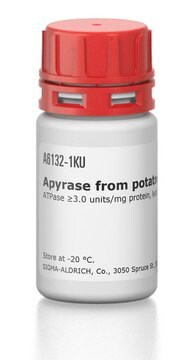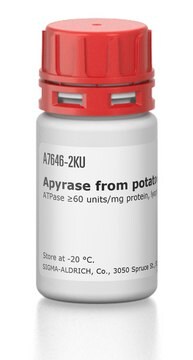Wszystkie zdjęcia(1)
Kluczowe dokumenty
A2230
Apyrase from potatoes
High Activity, ATPase ≥600 units/mg protein, lyophilized powder
Synonim(y):
Adenosine 5′-diphosphatase, Adenosine 5′-triphosphatase
Zaloguj sięWyświetlanie cen organizacyjnych i kontraktowych
About This Item
Numer CAS:
Numer MDL:
Kod UNSPSC:
12352204
NACRES:
NA.54
Polecane produkty
pochodzenie biologiczne
potato
Formularz
lyophilized powder
jakość
High Activity
ATPase activity
≥600 units/mg protein
secondary activity
≥50 % of base activity ADPase
skład
protein, ≥30%
obecność zanieczyszczeń
Acid Phosphatase ≤2% of base activity
Warunki transportu
wet ice
temp. przechowywania
−20°C
Szukasz podobnych produktów? Odwiedź Przewodnik dotyczący porównywania produktów
Zastosowanie
Apyrase is used to hydrolyze nucleoside triphosphates and diphosphates. Apyrase, from Sigma, has been used in inhibition studies of platelet-aggregation . Product A2230 is a high activity apyrase.
At least two isoenzymes are found in different varieties of S. tuberosum: one with a high ATPase/ADPase ratio (∼10) and another with a low ratio (∼1).
Reaction: ATP → ADP+Pi → AMP+2Pi.
Reaction: ATP → ADP+Pi → AMP+2Pi.
Działania biochem./fizjol.
Apyrase is found in all eukaryotes and some prokaryotes. Apyrase, from potato, has a crucial role in regulating growth and development. Apyrase is involved in the inactivation of synaptic ATP as a neurotransmitter following nerve stimulation and in the inhibition of ADP induced platelet aggregation to prevent thrombosis . Divalent metal ions are required for activity and best activity is observed with calcium ion at 5 mM.
Opakowanie
Sold on the basis of ATPase units.
Definicja jednostki
One unit will liberate 1.0 μmole of inorganic phosphate from ATP or ADP per min at pH 6.5 at 30 °C.
Postać fizyczna
Lyophilized powder containing potassium succinate buffer salts.
Uwaga dotycząca przygotowania
Derived from red potato
Ta strona może zawierać tekst przetłumaczony maszynowo.
Hasło ostrzegawcze
Danger
Zwroty wskazujące rodzaj zagrożenia
Zwroty wskazujące środki ostrożności
Klasyfikacja zagrożeń
Resp. Sens. 1
Kod klasy składowania
11 - Combustible Solids
Klasa zagrożenia wodnego (WGK)
WGK 3
Temperatura zapłonu (°F)
Not applicable
Temperatura zapłonu (°C)
Not applicable
Wybierz jedną z najnowszych wersji:
Masz już ten produkt?
Dokumenty związane z niedawno zakupionymi produktami zostały zamieszczone w Bibliotece dokumentów.
Klienci oglądali również te produkty
Mathieu F Chevalier et al.
Blood, 121(1), 29-37 (2012-10-09)
Natural regulatory T cells (Tregs) participate in responses to various chronic infections including HIV. HIV infection is associated with a progressive CD4 lymphopenia and defective HIV-specific CD8 responses known to play a key role in the control of viral replication.
Nicholas J Roberts et al.
Plant physiology, 161(1), 556-567 (2012-11-09)
Nodulation in legumes requires the recognition of rhizobially made Nod factors. Genetic studies have revealed that the perception of Nod factors involves LysM domain receptor-like kinases, while biochemical approaches have identified LECTIN NUCLEOTIDE PHOSPHOHYDROLASE (LNP) as a Nod factor-binding protein.
Tsan-Yu Chiu et al.
Plant & cell physiology, 53(11), 1913-1925 (2012-10-05)
Nucleoside triphosphate diphosphohydrolases (NTPDases; apyrases) (EC 3.6.1.5) hydrolyze di- and triphosphate nucleotides, but not monophosphate nucleotides. They are categorized as E-type ATPases, have a broad divalent cation (Mg(2+), Ca(2+)) requirement for activation and are insensitive to inhibitors of F-type, P-type
Ana Carolina Ribeiro Gomes Maia et al.
Parasitology international, 62(1), 44-52 (2012-09-22)
We identified a shared B domain within nucleoside triphosphate diphosphohydrolases (NTPDases) of plants and parasites. Now, an NTPDase activity not affected by inhibitors of adenylate kinase and ATPases was detected in Leishmania infantum promastigotes. By non-denaturing gel electrophoresis of detergent-homogenized
Gabriane Nascimento Porcino et al.
Experimental parasitology, 132(2), 293-299 (2012-08-28)
Nucleoside triphosphate diphosphohydrolase (NTPDase) activity was recently characterized in Leishmania (Viannia) braziliensis promastigotes (Lb), and an antigenic conserved domain (r82-121) from the specific NTPDase 1 isoform was identified. In this work, mouse polyclonal antibodies produced against two synthetic peptides derived
Nasz zespół naukowców ma doświadczenie we wszystkich obszarach badań, w tym w naukach przyrodniczych, materiałoznawstwie, syntezie chemicznej, chromatografii, analityce i wielu innych dziedzinach.
Skontaktuj się z zespołem ds. pomocy technicznej














